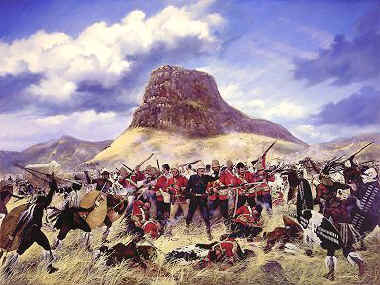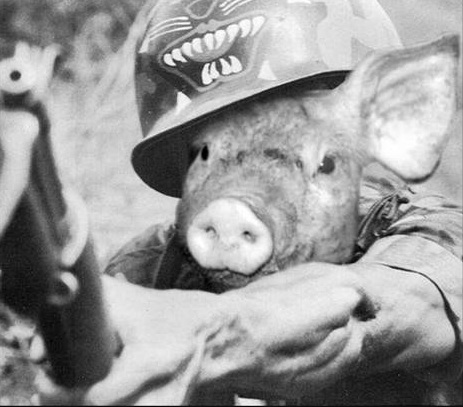Facts 5 to 8
5 The War Of The Fleeing Wife (1879)
 How could it possibly be that one of the most intelligent people who has ever lived, Albert Einstein, was born in the same year as one of the stupidest wars ever? I know, it’s pure coincidence, but it does show the amazing contrast of the year. One amazing man of remarkable intelligence entering the world in the same year that us humans found yet another dumb rear reason to throw hatchets at one another.
How could it possibly be that one of the most intelligent people who has ever lived, Albert Einstein, was born in the same year as one of the stupidest wars ever? I know, it’s pure coincidence, but it does show the amazing contrast of the year. One amazing man of remarkable intelligence entering the world in the same year that us humans found yet another dumb rear reason to throw hatchets at one another.
The War of the Fleeing Wife has echoes of the Iliad. But where the tragedy of the Greek Iliad was a deceitful wife, this war appears to have come down to a spousal dispute, which really aren’t that uncommon.
If you’re like me, and aware of the old saying, beware the woman scorned, you usually keep your head laying pretty low when the wife isn’t all that happy with you. It’s often best to just agree, admit that you were wrong, YOU WERE WRONG, and when the temperature cools down, try to enter the house again. It’s often the best and safest practice. But sometimes, and really a lot of the time, the male in the relationship is just an abusive prick. In these situations it’s often better for the wife to do the running, and never go back. Well, this was the basis for the War of the Fleeing Wife in 1879.
Two wives of a Zulu chief Sihayo kaXonga, ran from their husband. The women ran and hid in British held territory, believing they may have been safe. The problem was that the brother and sons of kaXonga pursued the women, capturing them and then killing them. The British were less than impressed, mainly because their territory was invaded, and following a few ultimatums that were ignored, went to war.
This was actually part of the Anglo-Zulu war of 1879. Following some bloody encounters, the Zulu were eventually crushed, with the loss of over 6,000 Zulu’s and 1727 British men.
6 The Paraguayan War (1864-1870)
 As far as positively pointless conflicts go, the Paraguayan War is certainly up there among the best. In short, it was a war that didn’t need to happen, and never should have happened. But, Paraguayan president, Francisco Solano Lopez was hell bent on becoming a great military leader.
As far as positively pointless conflicts go, the Paraguayan War is certainly up there among the best. In short, it was a war that didn’t need to happen, and never should have happened. But, Paraguayan president, Francisco Solano Lopez was hell bent on becoming a great military leader.
There’s a chance that you may have picked up a subtle little hint within the opening paragraph. President Francisco Solano Lopez wanted to be a great military leader, just like his idol Napoleon Bonaparte. But unlike the French leader, he was lacking one essential ingredient for military success. A war of course. But he had no real reason to worry, because being president gives you the privilege to, oh I don’t know, declare war if the need was there.This is what he did, rather foolishly too I must say.
President Lopez had absolutely no reason to go to war other than to fulfill his own mad dreams to copy his idol. But nonetheless this is what he did, and he didn’t do it by halves either. Instead of creating some proxy war or targeting a small isolated nation, he went ahead and declared war on three of his neighbors, Argentina, Brazil and Uruguay ensuring his own country was completely outnumbered, outgunned and surrounded. Brilliant military mind at work, right?
Over the course of six years Paraguay was almost completely annihilated by its neighbors. The country became occupied by Brazil, and a third of the population was killed. Thankfully for what was left of the populace, the government was removed. The total human cost of the Paraguayan War stood at 400,000 soldiers and civilians dead. And it could have been completely avoided, had president Lopez not been chasing a fantasy.
7 The Pig War I (1859)
The first Pig War in 1859 took place on the American and Canadian border on the west coast. Way back then there was no real defined border separating the two nations, alright, nation and colony. Sitting in the middle of the confused boundry was the San Juan islands, which both the US and Britain claimed. So just to make a point, the British went ahead and settled the disputed islands, as they often did, and set up a sheep farm. No harm right? No one was there or using the land, what harm could this cause. Well, imagine the shock when 25 Americans arrived on the island in 1859 to occupy land they thought was theirs.
Things seemed to go along alright for a while on the disputed islands, with both the British and Americans living in tense harmony. But no one was prepared for a pig to stir things up.
On June 15, 1859, Lyman Cutlar, one of the American settlers, noticed a pig digging in his vegetable garden. Less than impressed with the sight of a pig eating his food, he shot and killed the pig. Obviously the owner of the pig, an Irishman by the name of Charles Griffin who was on the British side of the islands wasn’t very happy that his pig was now dead. Cutlar offered Griffin $10 in compensation for the dead farm animal, but Griffin demanded $100, to which Cutlar defended himself by saying that the pig shouldn’t have been on his land and eating his potatoes. Griffin actually retorted to Cutlars defense with “it’s up to you to keep your potatoes out of my pig.”
Now this is where things start to get a little dangerous, and the drums of war begin to beat. The British went to arrest Cutlar, and he requested assistance from the US military who sent 66 soldiers. To counter this military presence on the island the British responded in kind, and upped the ante by sending in two warships. Al this over a dead pig. But if things weren’t bad enough yet, tensions were about to escalate.
By 10 August, there were five British warships with 2140 men, and 461 Americans with 14 cannons. This was shaping up to be a real wild ride. Just when you think that things can’t possibly get any worse, the British were ordered to remove the Americans by force. But thankfully the British commander decided to ignore the orders.
Over the next 12 years tensions subsided, and both the British and American military occupied the islands harmoniously, even paying each other friendly visits from time to time. The final outcome of the war was one dead pig, and an eternity of embarrassment for both sides.
There was a second Pig War in Europe between Austria and Serbia from 1906 to 1908. In this instance it pertained to an Austrian trade embargo on Serbian pork, which was their greatest export. Though the two sides never came to blows, each side openly criticized the other, and the relationship was less than cordial. This proved the second time in less than 50 years that a pig can be a reason for going to war
8 The Emu War (1932)
 Alright, once again an animal is the cause of bloody conflict. But at least this time they were also one of the belligerents. The Emu War as it would become known was less of a war and more of a mass culling exercise.
Alright, once again an animal is the cause of bloody conflict. But at least this time they were also one of the belligerents. The Emu War as it would become known was less of a war and more of a mass culling exercise.
In 1932 Australia was literally being overrun with Emu’s. The emu is of course the second largest bird in the world. They were in plague numbers in some regions, and were decimating crops. In response to the pleas from farmers, the Australian military jokingly declared war on the birds and sent in the military to conduct genocide.
A task force of the Australian army was sent out to cull the birds, even fit out with machine guns. But the emus proved a worthy foe, exhibiting bullet evasion techniques that any action hero would be proud of. But if they were hit, even several times, they made Rambo look like a pussy, continuing to run, and outrun their adversary.
If we had a military division with the bullet-carrying capacity of these birds it would face any army in the world…They can face machine guns with the invulnerability of tanks. They are like Zulus whom even dum-dum bullets could not stop – Major Meredith, commander of Australian forces
After a week of conflict the Australian army pulled the pin on the exhibition admitting a partial defeat. They just couldn’t kill as many as they wanted or hoped to.
For their trouble, the emus suffered 2,500 dead, while the Aussies suffered humiliation. But following this failed attempt, the government instigated a bounty system which proved successful. In a six month period in 1934, 57,034 bounties had been claimed.
[aio_button align=”right” animation=”none” color=”gray” size=”large” icon=”none” text=”NEXT PAGE” relationship=”dofollow” url=”https://unrealfacts.com/stupidest-wars-history-ever/3/”]








